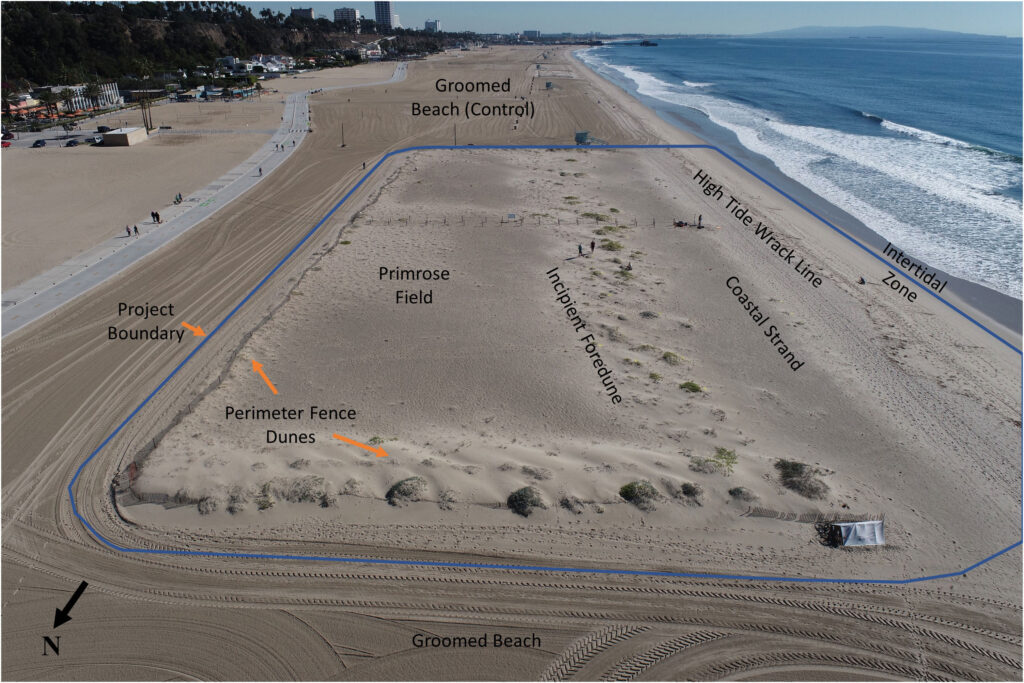Reestablishing Coastal Resilience: The Santa Monica Beach Dune Restoration
The relentless erosion of California’s beaches has raised alarms among environmental advocates, prompting proactive measures to combat the ongoing effects of climate change. A notable initiative has emerged from The Bay Foundation, a local nonprofit led by Tom Ford, aimed at restoring the natural landscape of Santa Monica Beach by encouraging the growth of indigenous sand dune vegetation.
A Strategic Approach
In Ford’s words, the foundation first aimed to “enhance the coastline” while addressing issues like rising sea levels and intensified storm activity. To combat these challenges, the foundation implemented a plan to end the damaging practice of beach grooming and promote the re-establishment of sand dunes.
Following a successful precedent further south, the foundation marked off a three-acre section of Santa Monica Beach in late 2015, where they sowed a mix of native seeds, including beach evening primrose and sand verbena. Ensuing heavy rains provided an ideal scenario for those seeds to germinate and thrive.
Natural Dune Formation
As the native plants took root, they began accumulating windblown sand, gradually forming dunes that act as a natural barrier against coastal erosion. While the project did not set specific success metrics, Ford considers it a substantial triumph. The developing dunes have now reached heights between one and three feet, reinforcing the area’s natural defense.
Community Engagement and Public Respect
A significant concern for Ford was whether the public would respect the designated area. Without erecting a tall fence, the foundation was left with no choice but to observe how visitors would react. Fortunately, Ford reported a positive outcome: “Everybody has responded beautifully. There has not been a single incident of vandalism, and families have taken delight in discovering the natural beauty of the site.”
Mother Nature Tests the Dunes
The resilience of the newly formed dunes was put to the test in January 2023, when a powerful storm brought heavy ocean swells and high tides to Los Angeles beaches. While several areas experienced significant erosion, the restored section showed no signs of damage. The storm’s waves ceased at the dunes’ edge, contrasting sharply with the situation at groomed beaches, where high-water levels penetrated up to 30 meters further inland.
The Science Behind Dune Restoration
According to Timu Gallien, a civil and environmental engineering professor at UCLA, sand dunes play a crucial role in mitigating coastal erosion. They act as a natural barricade against wave run-up during high tides, allowing waves to percolate into the dunes rather than inundating the infrastructure behind them. Gallien noted the effectiveness of similar restoration efforts, like one at Cardiff State Beach, which has set a precedent for future coastal projects.
Key Project Insights
| Aspect | Details |
|---|---|
| Project Area | Three acres (12,140 sq m) |
| Native Plants Used | Beach evening primrose, sea scale, flowering sand verbena |
| Dune Growth | 1 to 3 feet (30 to 90 cm) tall |
| Sand Accumulation | Approximately 2,760 metric tonnes since December 2016 |
| Future Plans | Expand by an additional 40 acres |
Looking Ahead
Inspired by the success of this initiative, the foundation has expanded its restoration efforts to an additional five acres and is gearing up for a more extensive 40-acre plan. As neighboring beach officials show renewed interest in similar coastal restoration projects, Ford confidently asserts, “People are going to love it. It’s going to be gorgeous.”


